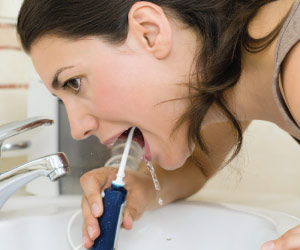Cleaning Between Your Teeth
How Water Flossing Can Help
Dear Doctor,
Are there any alternatives to flossing? It is so time-consuming, and I don’t seem to be very good at it.

Dear Christina,
I understand your predicament; lots of people find flossing difficult, and some don’t really have the dexterity to do it well. However, it is extremely important to clean between your teeth every day — in fact, your oral health depends on it! Why? Each day, a sticky, bacteria-rich film builds up on teeth. This biofilm, or dental plaque, is responsible for both periodontal (gum) disease and tooth decay. So you need to remove it not just from the surfaces of your teeth but also in between the teeth and at the gum line. Flossing is the best way to ensure you remove as much plaque as possible. But if you are not able to do it effectively, you may benefit from another method of interdental (between-the-teeth) cleaning known as oral irrigation.
Flushed Away
Maybe you’ve heard the term “irrigation” used to describe the delivery of water to farmland. Oral irrigators, available for home use since the early 1960s, deliver water to the oral cavity — i.e., the mouth. They work by pulsating water at high pressure through a handheld or countertop device that looks something like a power toothbrush (except with a special tip) to flush material from between teeth and below the gums. Also called “water flossers,” they can come with a variety of tips to address different dental situations, such as the presence of braces or implants.
Over the years, many studies have been done to examine the effectiveness of oral irrigation. Generally, what they have found is that they can be very helpful in controlling plaque — particularly in people who are having trouble maintaining their oral hygiene for various reasons.
For example, many people with braces avoid flossing because it’s just too hard to get the floss around all the hardware used in orthodontic (teeth-straightening) treatment. Unfortunately, this hardware can collect a tremendous amount of food debris and bacteria that is very difficult to remove with brushing alone. But here’s some good news: A 2008 study found that orthodontic patients who used an oral irrigator with a specialized orthodontic tip after brushing their teeth manually were able to remove five times as much plaque as those who just used a manual toothbrush.
Dental professionals also sometimes use oral irrigation in the office to help treat gum disease.
Controlling Gum Disease
Dental professionals also sometimes use oral irrigation in the office to help treat gum disease. People with gum disease often experience a loss of attachment between their gum tissue and their teeth. As their gums become inflamed by the presence of harmful bacteria, the tissue can gradually separate from the teeth. This causes the formation of pockets between the gums and teeth that collect more concentrated, disease-causing biofilm. When this happens, plaque builds up on the tooth-root surfaces, perpetuating inflammation and infection. If the situation is not brought under control, tooth-supporting bone can start to deteriorate. In the most serious cases of periodontal disease (“peri” – around; “odont” – tooth), teeth can loosen and even fall out.
The first step in treating gum disease — even the mildest form, called gingivitis (“gingiva” – gum; “it is” – inflammation) — is good oral hygiene coupled with a thorough professional cleaning. Where it has progressed to a more serious form of disease called periodontitis, in which pocketing has already occurred, a deep cleaning of the tooth-root surfaces called root planing and debridement will be needed. This cleaning is usually carried out by a dental hygienist, dentist or periodontist (gum disease specialist) who will thoroughly remove plaque and tartar from the tooth-root surfaces beneath the gum line with manual and/or power instruments.
Some offices use oral irrigation or ultrasonic devices to flush out pockets during or after scaling and root planing procedures — which may include a prescription antimicrobial medication such as chlorhexidine — to ensure removal of bacteria and other debris. In addition, research has found application of high-concentration antibiotics such as tetracycline after these procedures to be helpful in improving periodontal health. Studies show, however, that bacterial biofilm will rebound within weeks after treatment, which is why a good home-care routine is so important to help maintain the results. The American Academy of Periodontology, a professional association of periodontists, has noted that an oral irrigator used at home can help with this.
Don’t Go It Alone
I hope you’re beginning to see why it’s so important to find a way to effectively clean between your teeth — however you are best able to accomplish this. I would suggest you ask your dental hygienist to demonstrate techniques of flossing and oral irrigation for you at your dentist’s office. You may find that with practice, you become better at flossing than you thought you could. Let your dental professionals help you decide how best to maintain your oral health and keep your own, natural teeth for many years to come.



